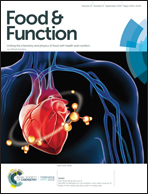Bioaccessibility of polymethoxyflavones encapsulated in resistant starch particle stabilized Pickering emulsions: role of fatty acid complexation and heat treatment†
Abstract
High-amylose maize starch formed complexes with different fatty acids (C12:0, C14:0, C16:0, C18:0 and C18:1) when two hydrothermal methods were used. The resistances of these starch complexes against enzymatic hydrolysis were all higher than that of the native starch, while the hydrophobicity of these complexes was enhanced. The capabilities of these starch-fatty acid complexes to form Pickering emulsions were further characterized. Starch-saturated fatty acid complexes were able to form stable emulsions that endured heat treatment at 60, 80 and 100 °C. However, starch-unsaturated fatty acid complexes could not form stable emulsions. The barrier properties of these emulsions were adjusted by the swelling of starch granules resulting from heat treatment. Lipolysis profiles of polymethoxyflavone (PMF) loaded emulsions suggested that certain heat treatments could reduce the accessibility of lipase towards oil droplets and release of PMFs during lipolysis by enhancing the coverage of granules at the oil–water interface. The resistant starch particle stabilized Pickering emulsions have the potential to encapsulate and enhance the bioaccessibility of poorly soluble phytochemicals in food and pharmaceutical products.



 Please wait while we load your content...
Please wait while we load your content...